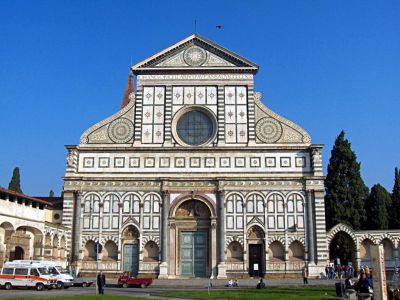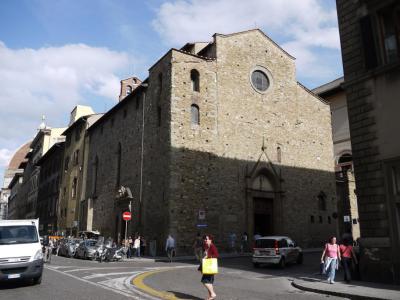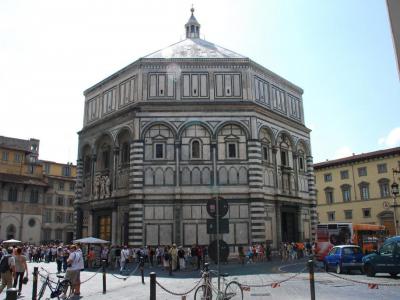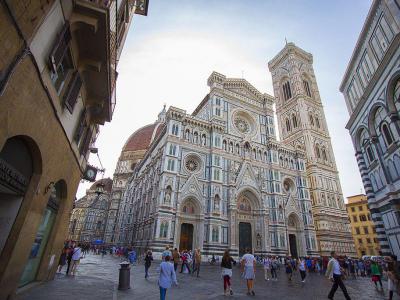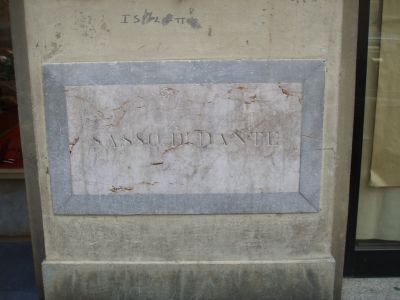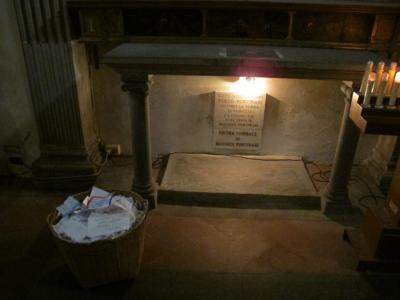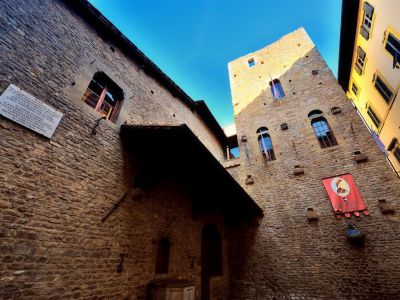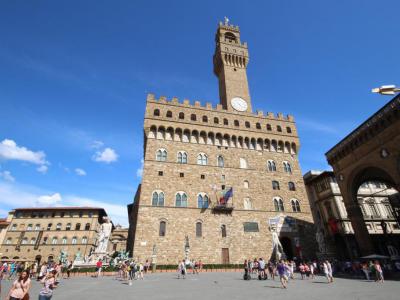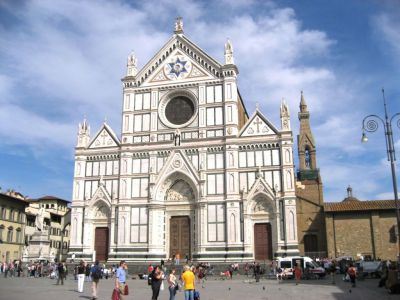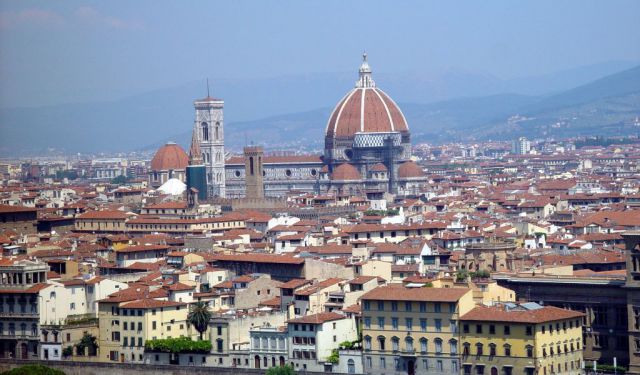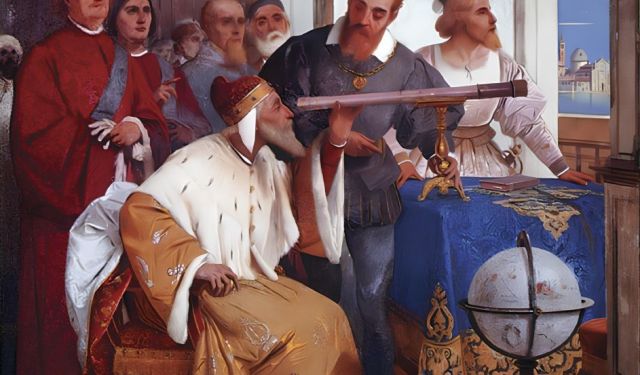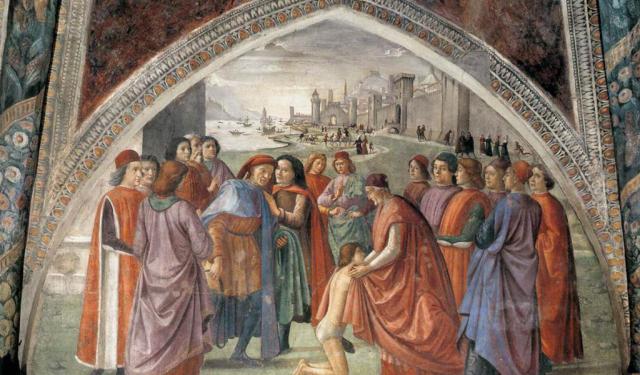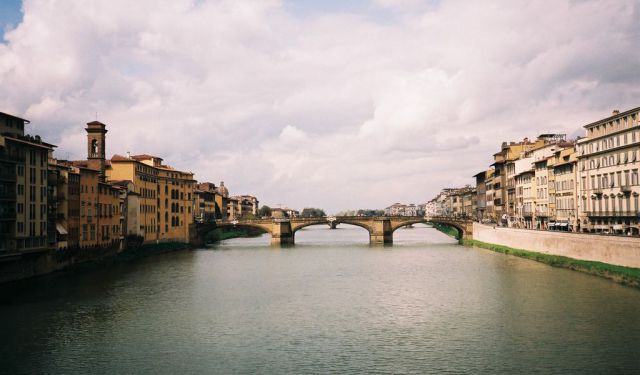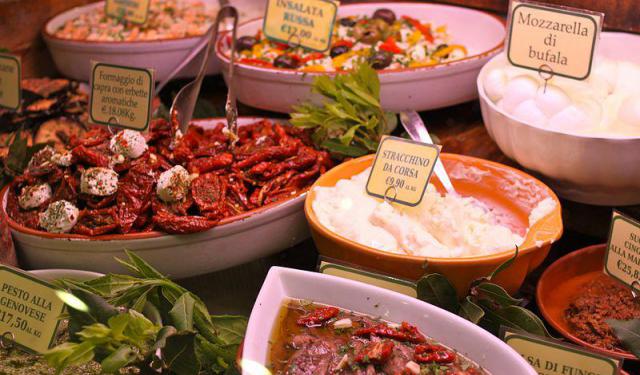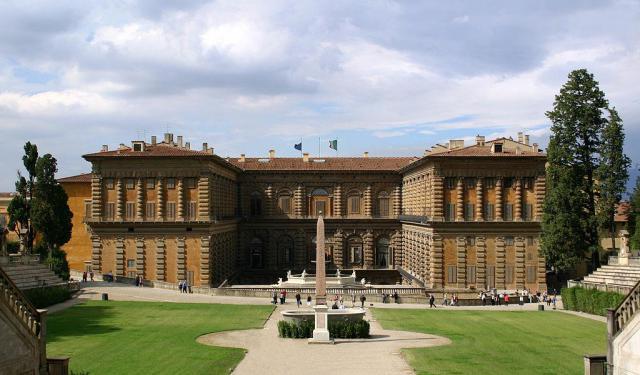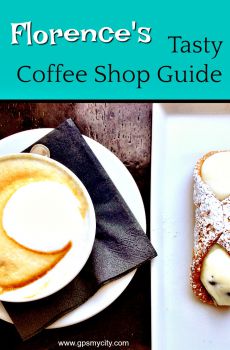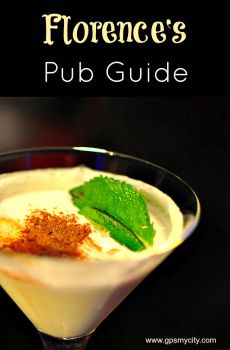Dante's Florence Walking Tour (Self Guided), Florence
Dante Alighieri was arguably the greatest – albeit also most controversial – of Italy's poets. After having served as one of the six priors governing Florence, his political activities – including the banishing of several rivals – led to his own banishment, upon which he wrote his masterpiece, “The Divine Comedy”, as a wanderer, seeking protection for his family in one town after another. This self-guided tour will take you on a trip through Dante's life and work in Florence, before and after the exile.
Born in May 1265, Dante was baptized in the Florence Baptistery, diagonally opposite the Duomo Cathedral, and was later trained as a doctor. His life changed dramatically when, at only 9 years old, he set eyes on Beatrice Portinari and fell in love with her. They ended up marrying other people, but Beatrice remained Dante’s muse, inspiring him to write lofty poetry. You can even visit the stone from where Dante would contemplate and write poems on summer evenings while watching the Florence Cathedral being built. Further along the way, the Church of Santa Margherita dei Cerchi is where the poet officialized his arranged marriage and also where Beatrice, his lifelong love, is said to be buried.
Although Dante’s own resting place is in Ravenna, Florence owns one of his death masks that you can see at Palazzo Vecchio – one of the oldest and most interesting of the many palaces in the city. At the very end of the walk, Basilica di Santa Croce houses Dante’s empty sarcophagus, while a monument to the poet stands in the piazza outside.
Dante left a large footprint in Florence, both during his lifetime and since his death. With so much to see, take this self-guided walking tour to follow in the steps of the Divine Comedy’s famous author.
Born in May 1265, Dante was baptized in the Florence Baptistery, diagonally opposite the Duomo Cathedral, and was later trained as a doctor. His life changed dramatically when, at only 9 years old, he set eyes on Beatrice Portinari and fell in love with her. They ended up marrying other people, but Beatrice remained Dante’s muse, inspiring him to write lofty poetry. You can even visit the stone from where Dante would contemplate and write poems on summer evenings while watching the Florence Cathedral being built. Further along the way, the Church of Santa Margherita dei Cerchi is where the poet officialized his arranged marriage and also where Beatrice, his lifelong love, is said to be buried.
Although Dante’s own resting place is in Ravenna, Florence owns one of his death masks that you can see at Palazzo Vecchio – one of the oldest and most interesting of the many palaces in the city. At the very end of the walk, Basilica di Santa Croce houses Dante’s empty sarcophagus, while a monument to the poet stands in the piazza outside.
Dante left a large footprint in Florence, both during his lifetime and since his death. With so much to see, take this self-guided walking tour to follow in the steps of the Divine Comedy’s famous author.
How it works: Download the app "GPSmyCity: Walks in 1K+ Cities" from Apple App Store or Google Play Store to your mobile phone or tablet. The app turns your mobile device into a personal tour guide and its built-in GPS navigation functions guide you from one tour stop to next. The app works offline, so no data plan is needed when traveling abroad.
Dante's Florence Walking Tour Map
Guide Name: Dante's Florence Walking Tour
Guide Location: Italy » Florence (See other walking tours in Florence)
Guide Type: Self-guided Walking Tour (Sightseeing)
# of Attractions: 9
Tour Duration: 1 Hour(s)
Travel Distance: 2.1 Km or 1.3 Miles
Author: greghasleft
Sight(s) Featured in This Guide:
Guide Location: Italy » Florence (See other walking tours in Florence)
Guide Type: Self-guided Walking Tour (Sightseeing)
# of Attractions: 9
Tour Duration: 1 Hour(s)
Travel Distance: 2.1 Km or 1.3 Miles
Author: greghasleft
Sight(s) Featured in This Guide:
- Basilica di Santa Maria Novella (Basilica of Santa Maria Novella)
- Chiesa di Santa Maria Maggiore (Church of Saint Mary Major)
- Battistero di San Giovanni (Baptistery of St. John)
- Cattedrale di Santa Maria del Fiore (Florence Cathedral)
- Sasso di Dante (Stone of Dante)
- Chiesa di Santa Margherita de' Cerchi (Church of St. Margaret)
- Casa di Dante (Dante House-Museum)
- Palazzo Vecchio (Old Palace)
- Basilica di Santa Croce (Basilica of the Holy Cross)
1) Basilica di Santa Maria Novella (Basilica of Santa Maria Novella)
Built in the 13th century, Santa Maria Novella is, chronologically, the first grand basilica in Florence, and stands as the city's principal Dominican church. Within its walls, along with the adjacent cloister and chapter house, lie a multitude of art treasures and funerary monuments. Especially famous are frescoes crafted by Gothic and early Renaissance masters, generously funded by prominent Florentine families, securing for themselves funerary chapels on consecrated ground.
The exterior showcases architectural elements inspired by antiquity, including the pediment and frieze; however, the upper portion introduces a novel and unprecedented design feature: S-curved scrolls. These scrolls, or variations thereof, can be found in churches across Italy and owe their origins to the innovative design of Santa Maria Novella, which ingeniously addressed the challenge of transitioning from wide to narrow storeys.
Beyond its architectural splendor and captivating cloisters, the basilica houses an array of artistic treasures, including frescoes, statues, paintings, and wooden crosses. Notable among them is the world-famous fresco "The Holy Trinity" by Masaccio, which had a profound impact on Florentine painting, inspiring future generations with its groundbreaking use of perspective and mathematical proportions. Additionally, the pulpit designed by Brunelleschi himself is of historical significance, as it was from this very pulpit that the first verbal attack against Galileo Galilei was launched, ultimately leading to his indictment.
Be sure not to overlook the Cappella Strozzi di Mantova, situated at the end of the left transept. Adorned with frescoes inspired by Dante's "Divine Comedy", this chapel portrays the Last Judgment (on the back wall, featuring a portrait of Dante), Hell (on the right wall), and Paradise (on the left wall). Executed between 1350 and 1357, these remarkable artworks vividly bring to life the essence of Dante's renowned literary masterpiece.
The exterior showcases architectural elements inspired by antiquity, including the pediment and frieze; however, the upper portion introduces a novel and unprecedented design feature: S-curved scrolls. These scrolls, or variations thereof, can be found in churches across Italy and owe their origins to the innovative design of Santa Maria Novella, which ingeniously addressed the challenge of transitioning from wide to narrow storeys.
Beyond its architectural splendor and captivating cloisters, the basilica houses an array of artistic treasures, including frescoes, statues, paintings, and wooden crosses. Notable among them is the world-famous fresco "The Holy Trinity" by Masaccio, which had a profound impact on Florentine painting, inspiring future generations with its groundbreaking use of perspective and mathematical proportions. Additionally, the pulpit designed by Brunelleschi himself is of historical significance, as it was from this very pulpit that the first verbal attack against Galileo Galilei was launched, ultimately leading to his indictment.
Be sure not to overlook the Cappella Strozzi di Mantova, situated at the end of the left transept. Adorned with frescoes inspired by Dante's "Divine Comedy", this chapel portrays the Last Judgment (on the back wall, featuring a portrait of Dante), Hell (on the right wall), and Paradise (on the left wall). Executed between 1350 and 1357, these remarkable artworks vividly bring to life the essence of Dante's renowned literary masterpiece.
2) Chiesa di Santa Maria Maggiore (Church of Saint Mary Major)
Originally constructed in the 11th century, Florence's Santa Maria Maggiore may not possess the same grandeur as other churches in Florence, but it is undeniably beautiful. In the 13th century, it underwent extensive Gothic-style renovations to its facade and sides; however, the exterior retains a relatively plain appearance, characterized by stone walls and portals crowned with tympani. The bell tower, a remnant of the Romanesque structure, still stands, albeit reduced in height. Interestingly, it features a mysterious carving of a woman's head – popularly known as "Berta" – embedded in its walls.
The interior, restored in the 17th century, is simple with a nave and two aisles, ogival arches and groin vaults. Artworks include frescoes by Bernardino Poccetti, a Nativity by Matteo Rosselli, and, above the altar of the left transept chapel, a polychromed stucco relief panel, the Madonna del Carmelo, long attributed to the 13th-century artist, Coppo di Marcovaldo. If you need a place to rest and/or pray peacefully, this off-tourist-path church is the right place in Florence.
The interior, restored in the 17th century, showcases a simple layout with a nave, two aisles, ogival arches, and groin vaults. Noteworthy artworks include frescoes by Bernardino Poccetti, a Nativity painting by Matteo Rosselli, and a polychromed stucco relief panel, and the Madonna del Carmelo, positioned above the altar in the left transept chapel. For those seeking a tranquil space to rest or pray away from the tourist crowds, this off-the-beaten-path church in Florence provides a serene sanctuary.
***DANTE'S FLORENCE TOUR***
Within the church's chapel, take a moment to find the tomb of the renowned scholar and philosopher Brunetto Latini, who once served as Dante's mentor and introduced him to the writings of ancient authors. Latini was also a prominent figure in Florentine politics, serving as an influential role model for the aspiring poet, who was deeply engaged with the political life of his city. Dante certainly admired his teacher and held him in high esteem, though in his "Divine Comedy", for some unclear reason, he sticks Latini in the seventh circle of Hell, among the sodomites.
The interior, restored in the 17th century, is simple with a nave and two aisles, ogival arches and groin vaults. Artworks include frescoes by Bernardino Poccetti, a Nativity by Matteo Rosselli, and, above the altar of the left transept chapel, a polychromed stucco relief panel, the Madonna del Carmelo, long attributed to the 13th-century artist, Coppo di Marcovaldo. If you need a place to rest and/or pray peacefully, this off-tourist-path church is the right place in Florence.
The interior, restored in the 17th century, showcases a simple layout with a nave, two aisles, ogival arches, and groin vaults. Noteworthy artworks include frescoes by Bernardino Poccetti, a Nativity painting by Matteo Rosselli, and a polychromed stucco relief panel, and the Madonna del Carmelo, positioned above the altar in the left transept chapel. For those seeking a tranquil space to rest or pray away from the tourist crowds, this off-the-beaten-path church in Florence provides a serene sanctuary.
***DANTE'S FLORENCE TOUR***
Within the church's chapel, take a moment to find the tomb of the renowned scholar and philosopher Brunetto Latini, who once served as Dante's mentor and introduced him to the writings of ancient authors. Latini was also a prominent figure in Florentine politics, serving as an influential role model for the aspiring poet, who was deeply engaged with the political life of his city. Dante certainly admired his teacher and held him in high esteem, though in his "Divine Comedy", for some unclear reason, he sticks Latini in the seventh circle of Hell, among the sodomites.
3) Battistero di San Giovanni (Baptistery of St. John)
The beautiful Florence Baptistery, dedicated to Saint John the Baptist-patron saint of the city-stands prominently on Cathedral Square, opposite the Duomo. Raised in the 7th century over an ancient Roman structure thought to be a temple honoring Mars, the building features a distinctive octagonal shape. Early Christians frequently chose this eight-sided design for baptisteries, symbolizing renewal-the six days of creation, one day of rest, and the day of rebirth through baptism.
During its renovation in 1059, artisans covered the baptistery in alternating bands of white and dark green marble, giving the exterior its striking striped appearance. Yet, the baptistery is perhaps most famous for the three remarkable sets of bronze doors. The south doors depict moments from Saint John's life, combined with beautiful representations of the eight Christian virtues. The north doors, crafted by Lorenzo Ghiberti over 21 long years, illustrate scenes from the life of Christ. Ghiberti later devoted another 27 years to the spectacular east doors, famously described by Michelangelo as the “Gates of Paradise.” This extraordinary artwork features ten elaborate panels portraying the story of Joseph.
Inside, visitors can gaze upward at magnificent mosaics decorating the ceiling and view the baptismal font, in use since 1576. Francesco de’ Medici, Florence’s powerful ruler, had his son baptized here-just one among numerous notable figures who have shared this honor, including generations of the influential Medici family. Indeed, nearly every Catholic Florentine, up until the 19th century, received baptism within these very walls, making the Baptistery a core component of the city's religious heritage.
Florence's beloved poet Dante references this cherished building in his masterpiece, the “Divine Comedy.” Born in May 1265, the poet was originally named Durante, meaning “enduring,” after his maternal grandfather-though eventually, his family shortened the name to Dante.
Tip: Your standard ticket for the Duomo attractions includes access to the Baptistery, valid for 72 hours. Note that there's a strict dress code: shoulders and knees must be covered for both men and women, so please dress appropriately. To attend the daily mass, arrive around 10:30 AM at the door opposite the main entrance and mention “mass” or “messa” to the attendant.
During its renovation in 1059, artisans covered the baptistery in alternating bands of white and dark green marble, giving the exterior its striking striped appearance. Yet, the baptistery is perhaps most famous for the three remarkable sets of bronze doors. The south doors depict moments from Saint John's life, combined with beautiful representations of the eight Christian virtues. The north doors, crafted by Lorenzo Ghiberti over 21 long years, illustrate scenes from the life of Christ. Ghiberti later devoted another 27 years to the spectacular east doors, famously described by Michelangelo as the “Gates of Paradise.” This extraordinary artwork features ten elaborate panels portraying the story of Joseph.
Inside, visitors can gaze upward at magnificent mosaics decorating the ceiling and view the baptismal font, in use since 1576. Francesco de’ Medici, Florence’s powerful ruler, had his son baptized here-just one among numerous notable figures who have shared this honor, including generations of the influential Medici family. Indeed, nearly every Catholic Florentine, up until the 19th century, received baptism within these very walls, making the Baptistery a core component of the city's religious heritage.
Florence's beloved poet Dante references this cherished building in his masterpiece, the “Divine Comedy.” Born in May 1265, the poet was originally named Durante, meaning “enduring,” after his maternal grandfather-though eventually, his family shortened the name to Dante.
Tip: Your standard ticket for the Duomo attractions includes access to the Baptistery, valid for 72 hours. Note that there's a strict dress code: shoulders and knees must be covered for both men and women, so please dress appropriately. To attend the daily mass, arrive around 10:30 AM at the door opposite the main entrance and mention “mass” or “messa” to the attendant.
4) Cattedrale di Santa Maria del Fiore (Florence Cathedral) (must see)
Towering over the city of Florence, the Florence Cathedral is a true Renaissance masterpiece-best known for its massive masonry dome, the largest of its kind in the world. Completed in 1465, this remarkable double-shell structure is entirely self-supporting and remains one of the greatest engineering marvels of its time.
The cathedral’s story begins in 1296, when construction of its Gothic design first got underway. The real breakthrough, however, came nearly 150 years later, when architect Filippo Brunelleschi stepped in to solve what many thought was an impossible challenge-building the dome. Inspired by the ancient Pantheon in Rome, Brunelleschi ran countless experiments using large-scale models and even invented custom machinery to get the job done.
Among his most remarkable inventions were lifting devices and pulley systems capable of raising over 37,000 tons of materials-including more than four million bricks. His work impressed a young apprentice named Leonardo da Vinci, who sketched the machines-drawings that were later mistakenly credited to him. But history has remembered the true innovator. Today, Brunelleschi’s statue stands in the piazza outside the Cathedral as a tribute to his genius.
Step inside, and you’ll find more treasures-like the fresco “Dante and the Divine Comedy” by Domenico di Michelino, painted in 1465. It shows the poet holding his famous book, surrounded by vivid imagery of Hell, Purgatory, and Heaven, along with a detailed view of Florence as it looked in the 15th century-ironically, a version of the city Dante himself never saw. To see it up close, be prepared to climb about 450 steps up a narrow staircase that spirals inside the dome.
And then there's the exterior-a stunning patchwork of colorful marbles so intricate it almost looks painted. The craftsmanship is nothing short of extraordinary.
Tip: When booking online, you’ll get free access to the top of the dome-but you’ll need to reserve a time slot separately. The reward is a 360-degree view of Florence, the Tuscan countryside, and the mountains beyond. Totally worth the climb.
The cathedral’s story begins in 1296, when construction of its Gothic design first got underway. The real breakthrough, however, came nearly 150 years later, when architect Filippo Brunelleschi stepped in to solve what many thought was an impossible challenge-building the dome. Inspired by the ancient Pantheon in Rome, Brunelleschi ran countless experiments using large-scale models and even invented custom machinery to get the job done.
Among his most remarkable inventions were lifting devices and pulley systems capable of raising over 37,000 tons of materials-including more than four million bricks. His work impressed a young apprentice named Leonardo da Vinci, who sketched the machines-drawings that were later mistakenly credited to him. But history has remembered the true innovator. Today, Brunelleschi’s statue stands in the piazza outside the Cathedral as a tribute to his genius.
Step inside, and you’ll find more treasures-like the fresco “Dante and the Divine Comedy” by Domenico di Michelino, painted in 1465. It shows the poet holding his famous book, surrounded by vivid imagery of Hell, Purgatory, and Heaven, along with a detailed view of Florence as it looked in the 15th century-ironically, a version of the city Dante himself never saw. To see it up close, be prepared to climb about 450 steps up a narrow staircase that spirals inside the dome.
And then there's the exterior-a stunning patchwork of colorful marbles so intricate it almost looks painted. The craftsmanship is nothing short of extraordinary.
Tip: When booking online, you’ll get free access to the top of the dome-but you’ll need to reserve a time slot separately. The reward is a 360-degree view of Florence, the Tuscan countryside, and the mountains beyond. Totally worth the climb.
5) Sasso di Dante (Stone of Dante)
Sasso di Dante was the stone from where Dante would contemplate and write poems on summer evenings while watching the Florence Cathedral being built. Although the stone itself is no longer to be found, a plaque on the southern wall of Piazza del Duomo, affixed to the side of a store that sells religious items, claims to mark the location where the stone once stood.
The last time Dante could have sat on his rock was in 1302, the year he was exiled from Florence, never to return. This site is also associated with an anecdote that highlights the renowned poet's exceptional memory. While deeply immersed in his thoughts, an acquaintance passed by and approached him, asking, "Oh Dante, what is your favorite food?" To which Dante replied, "eggs." The following year, the same inquisitive person encountered Dante still seated in his cherished spot and inquired, "with what?" Dante promptly responded, "with salt!"
In close proximity, you will find an old trattoria aptly named Sasso di Dante, occupying a significant portion of the piazza. Its covered outdoor seating area provides an ideal setting for a leisurely lunch in pleasant weather – a perfect opportunity to reflect on your day so far or plan for the adventures that lie ahead in the afternoon.
The last time Dante could have sat on his rock was in 1302, the year he was exiled from Florence, never to return. This site is also associated with an anecdote that highlights the renowned poet's exceptional memory. While deeply immersed in his thoughts, an acquaintance passed by and approached him, asking, "Oh Dante, what is your favorite food?" To which Dante replied, "eggs." The following year, the same inquisitive person encountered Dante still seated in his cherished spot and inquired, "with what?" Dante promptly responded, "with salt!"
In close proximity, you will find an old trattoria aptly named Sasso di Dante, occupying a significant portion of the piazza. Its covered outdoor seating area provides an ideal setting for a leisurely lunch in pleasant weather – a perfect opportunity to reflect on your day so far or plan for the adventures that lie ahead in the afternoon.
6) Chiesa di Santa Margherita de' Cerchi (Church of St. Margaret)
They call this "Dante's Church" since it is where his family attended and where, at the age of 20, he officialized his arranged marriage with Gemma Donati; however, it appears as if another woman – Beatrice Portinari – stole the spotlight here. Having first caught sight of her at this small church when he was only nine years old, Dante would for decades thereafter regard her as a symbol of perfect female beauty and spiritual virtue. Despite encountering Beatrice again nine years later, Dante never truly knew her and, in a highly Platonic manner of affection, never even spoke to her. Eventually, she married another man and tragically passed away at a fairly young age...
Beatrice undeniably exerted a significant influence on Dante's literary works. In the third and final part of the "Divine Comedy," she guides the exiled poet through the nine celestial spheres of Heaven, leading him to the Empyrean, the abode of God. Within this humble church, Beatrice's grave can be found to the left of the main entrance, often accompanied by a basket filled with notes of unrequited love. With its subdued lighting and serene atmosphere enhanced by soft classical music, the Church of Saint Margaret ("Santa Margherita") provides a peaceful setting for introspection and contemplation.
Beatrice undeniably exerted a significant influence on Dante's literary works. In the third and final part of the "Divine Comedy," she guides the exiled poet through the nine celestial spheres of Heaven, leading him to the Empyrean, the abode of God. Within this humble church, Beatrice's grave can be found to the left of the main entrance, often accompanied by a basket filled with notes of unrequited love. With its subdued lighting and serene atmosphere enhanced by soft classical music, the Church of Saint Margaret ("Santa Margherita") provides a peaceful setting for introspection and contemplation.
7) Casa di Dante (Dante House-Museum)
Florence underwent dramatic changes during the Renaissance, but in the city’s eastern quarter, you can still feel the spirit of the Middle Ages. Winding your way through its narrow alleys and tucked-away corners, you’ll find yourself stepping into scenes that Florence’s most famous poet, Dante Alighieri, would recognize even today. Not far from the parish church where he first laid eyes on Beatrice Portinari, his lifelong muse, stands Casa di Dante, the house believed to be his childhood home.
Now a three-story museum, the space offers a thoughtful look at the life and legacy of the man behind the “Divine Comedy”. On the ground floor, you’ll explore his early years in Florence. The second level focuses on the turning point of his life-the exile-and the time he spent in Ravenna, where he eventually died. Climb to the top floor, and you’ll find a collection of the poet’s personal items, along with replicas carefully recreated to reflect his world. One standout piece is a miniature edition of the “Divina Comedia”-the smallest printed version of the famous text, and a testament to its enduring legacy.
Dante’s epic poem takes the reader on a journey through the afterlife-guided first by the Roman poet Virgil through Hell and Purgatory, then by Beatrice through the realms of Paradise. Though Dante himself called the work simply "The Comedy," it gained popularity over the centuries, and in 1555, a lavish edition published in Venice gave us the name we know today.
Tip: The museum’s staircase is quite steep, but there is an elevator-just note that it’s a bit tucked away and might not be obvious when you first walk in. Keep an eye out, especially if you're hoping to skip the stairs.
Now a three-story museum, the space offers a thoughtful look at the life and legacy of the man behind the “Divine Comedy”. On the ground floor, you’ll explore his early years in Florence. The second level focuses on the turning point of his life-the exile-and the time he spent in Ravenna, where he eventually died. Climb to the top floor, and you’ll find a collection of the poet’s personal items, along with replicas carefully recreated to reflect his world. One standout piece is a miniature edition of the “Divina Comedia”-the smallest printed version of the famous text, and a testament to its enduring legacy.
Dante’s epic poem takes the reader on a journey through the afterlife-guided first by the Roman poet Virgil through Hell and Purgatory, then by Beatrice through the realms of Paradise. Though Dante himself called the work simply "The Comedy," it gained popularity over the centuries, and in 1555, a lavish edition published in Venice gave us the name we know today.
Tip: The museum’s staircase is quite steep, but there is an elevator-just note that it’s a bit tucked away and might not be obvious when you first walk in. Keep an eye out, especially if you're hoping to skip the stairs.
8) Palazzo Vecchio (Old Palace) (must see)
Just like the Cathedral complex and Florence’s world-class galleries, the Old Palace is essential for anyone wanting to grasp the city's history and cultural identity. This massive Romanesque fortress is one of the most striking town halls in all of Tuscany. Since 1872, it has served as the office of Florence’s mayor, but its legacy stretches much further back. Built in 1299, the edifice was the political heart of the Florentine Republic for centuries. When Cosimo de’ Medici moved in with his family in 1540 as Grand Duke, he had it expanded and transformed, blending its medieval bones with elegant Renaissance flair.
The rugged stone façade, lined with shields chronicling Florence’s political past, is also home to an impressive lineup of statues. These include Florence’s heraldic symbol- the Marzocco lion, along with Donatello’s powerful “Judith and Holofernes”, and “Hercules and Cacus”. The nearby Tower of Arnolfo, rising above the palace, offers a climbable vantage point-though access requires a separate ticket.
Meanwhile, inside, every room tells a chapter of the city’s history. You’ll walk through the spectacular Hall of the Five Hundred, designed to glorify Medici rule, and into the more private quarters where the family lived. Decorated under the artistic direction of Giorgio Vasari, these spaces are rich in symbolism and political narrative. Give yourself time to move slowly through the rooms-it’s an immersive dive into Florentine grandeur. And be warned: you may leave with a crick in your neck from gazing.
One standout work here is Michelangelo’s “Genius of Victory”. Originally meant for the tomb of Pope Julius II, the sculpture depicts a young, triumphant figure standing over a defeated older man. The contrast between the two is striking-the victor is smooth and polished, the vanquished figure unfinished and rough, still bearing the weight of the stone.
You’ll also come across something rather haunting-a death mask of Dante Alighieri, displayed between the Apartments of Eleanor and the Halls of the Priors. Though the poet was buried in Ravenna, this plaster cast has become a powerful reminder of his influence on Florence, both politically and culturally. Fans of Dan Brown’s “Inferno” will surely recognize it from the novel.
Tip: If you’re planning a guided visit, it’s best to book directly with the museum by email-include your preferred date and time, and wait for confirmation. Payment is made on the day of your tour, and afterward, you’re free to continue exploring on your own. Just keep in mind: because this is still a working municipal building, access may occasionally be restricted. It’s a good idea to check the official website before you go.
The rugged stone façade, lined with shields chronicling Florence’s political past, is also home to an impressive lineup of statues. These include Florence’s heraldic symbol- the Marzocco lion, along with Donatello’s powerful “Judith and Holofernes”, and “Hercules and Cacus”. The nearby Tower of Arnolfo, rising above the palace, offers a climbable vantage point-though access requires a separate ticket.
Meanwhile, inside, every room tells a chapter of the city’s history. You’ll walk through the spectacular Hall of the Five Hundred, designed to glorify Medici rule, and into the more private quarters where the family lived. Decorated under the artistic direction of Giorgio Vasari, these spaces are rich in symbolism and political narrative. Give yourself time to move slowly through the rooms-it’s an immersive dive into Florentine grandeur. And be warned: you may leave with a crick in your neck from gazing.
One standout work here is Michelangelo’s “Genius of Victory”. Originally meant for the tomb of Pope Julius II, the sculpture depicts a young, triumphant figure standing over a defeated older man. The contrast between the two is striking-the victor is smooth and polished, the vanquished figure unfinished and rough, still bearing the weight of the stone.
You’ll also come across something rather haunting-a death mask of Dante Alighieri, displayed between the Apartments of Eleanor and the Halls of the Priors. Though the poet was buried in Ravenna, this plaster cast has become a powerful reminder of his influence on Florence, both politically and culturally. Fans of Dan Brown’s “Inferno” will surely recognize it from the novel.
Tip: If you’re planning a guided visit, it’s best to book directly with the museum by email-include your preferred date and time, and wait for confirmation. Payment is made on the day of your tour, and afterward, you’re free to continue exploring on your own. Just keep in mind: because this is still a working municipal building, access may occasionally be restricted. It’s a good idea to check the official website before you go.
9) Basilica di Santa Croce (Basilica of the Holy Cross) (must see)
Santa Croce is one of the most celebrated Franciscan churches in the world and a jewel of Gothic architecture in Florence. Built over the 13th and 14th centuries, it’s often called the “Temple of Italian Glories”-and for good reason. This is where some of Italy’s greatest minds and artists are buried-among them Michelangelo, Galileo, Machiavelli, the poet Foscolo, and the composer Rossini.
Michelangelo’s journey back to Florence after death is itself the stuff of legend. Though he died in Rome, Cosimo de’ Medici made sure his remains returned home. The Medici ruler, unable to properly honor the artist in life, vowed to do so in death-and, to this end, commissioned an elaborate tomb. Designed by Giorgio Vasari, the tomb took 14 years to complete and features symbols tied to Michelangelo’s creative legacy. Three laurel wreaths represent his mastery of painting, sculpture, and architecture, each mourned by a figure carved in deep sorrow below his bust.
Galileo’s story follows a similarly complicated path. Though he died in 1642, his tomb wasn’t built until nearly a century later, in 1737, now facing Michelangelo’s across the nave. It’s adorned with allegorical figures representing Astronomy and Geometry, and quietly also includes the tomb of his daughter, Maria Celeste-though her presence often goes unnoticed.
Dante, however, remains absent. While Florence tried for years to reclaim his remains, the poet still lies in Ravenna, the city that welcomed him after exile. Here in Santa Croce, an empty sarcophagus stands in his honor, and a grand statue was erected outside the church in 1865 for his 600th birth anniversary.
The interior is filled with masterpieces by Giotto, Donatello, Vasari, Canova, and others too numerous to list in one breath. Outside, the tranquil cloisters and green courtyard offer a quiet space to pause or sketch, while the square hosts everything from live concerts to raucous games of Florentine “rugby.”
Tip: Be sure to stop by the Leather School just behind the church. You can watch apprentices at work and maybe find a unique handmade piece to take home. Just remember: modest attire is required-no bare shoulders or short shorts, especially for women, as the dress code is firmly enforced.
Michelangelo’s journey back to Florence after death is itself the stuff of legend. Though he died in Rome, Cosimo de’ Medici made sure his remains returned home. The Medici ruler, unable to properly honor the artist in life, vowed to do so in death-and, to this end, commissioned an elaborate tomb. Designed by Giorgio Vasari, the tomb took 14 years to complete and features symbols tied to Michelangelo’s creative legacy. Three laurel wreaths represent his mastery of painting, sculpture, and architecture, each mourned by a figure carved in deep sorrow below his bust.
Galileo’s story follows a similarly complicated path. Though he died in 1642, his tomb wasn’t built until nearly a century later, in 1737, now facing Michelangelo’s across the nave. It’s adorned with allegorical figures representing Astronomy and Geometry, and quietly also includes the tomb of his daughter, Maria Celeste-though her presence often goes unnoticed.
Dante, however, remains absent. While Florence tried for years to reclaim his remains, the poet still lies in Ravenna, the city that welcomed him after exile. Here in Santa Croce, an empty sarcophagus stands in his honor, and a grand statue was erected outside the church in 1865 for his 600th birth anniversary.
The interior is filled with masterpieces by Giotto, Donatello, Vasari, Canova, and others too numerous to list in one breath. Outside, the tranquil cloisters and green courtyard offer a quiet space to pause or sketch, while the square hosts everything from live concerts to raucous games of Florentine “rugby.”
Tip: Be sure to stop by the Leather School just behind the church. You can watch apprentices at work and maybe find a unique handmade piece to take home. Just remember: modest attire is required-no bare shoulders or short shorts, especially for women, as the dress code is firmly enforced.
Walking Tours in Florence, Italy
Create Your Own Walk in Florence
Creating your own self-guided walk in Florence is easy and fun. Choose the city attractions that you want to see and a walk route map will be created just for you. You can even set your hotel as the start point of the walk.
Duomo Walking Tour
Right in the heart of historic Florence lies the Duomo district-the city's religious and civic core, and one of the most remarkable places in all of Italy. Between the Duomo and Signoria squares, Florence unfolds in layers of art, history, and architectural brilliance, offering a never-ending stream of things to see, do, and admire.
At the center of it all stands the Florence Cathedral, or... view more
Tour Duration: 2 Hour(s)
Travel Distance: 2.3 Km or 1.4 Miles
At the center of it all stands the Florence Cathedral, or... view more
Tour Duration: 2 Hour(s)
Travel Distance: 2.3 Km or 1.4 Miles
In Galileo's Footsteps
Galileo Galilei-born in Pisa in 1564-spent much of his life in and around Florence, where some of the most defining moments of his revolutionary career unfolded. A genius of many talents-physicist, mathematician, astronomer, inventor-he helped usher in the scientific revolution and reshape humanity’s understanding of the universe. Florence, the cradle of the Renaissance, became a backdrop for... view more
Tour Duration: 3 Hour(s)
Travel Distance: 8.0 Km or 5 Miles
Tour Duration: 3 Hour(s)
Travel Distance: 8.0 Km or 5 Miles
Florence's Hidden Art Treasures
The “Cradle of the Renaissance,” Florence is one of Europe’s most beautiful and busiest destinations, home to some of the world's greatest pieces of art and architecture. The iconic masters like Giotto, Botticelli, Raphael and Michelangelo, as well as their somewhat less-known but equally talented counterparts, such as Ghirlandaio, Sangallo and Castagno, have blessed this city with... view more
Tour Duration: 2 Hour(s)
Travel Distance: 3.2 Km or 2 Miles
Tour Duration: 2 Hour(s)
Travel Distance: 3.2 Km or 2 Miles
Arno South Bank Walking Tour
The area south of the Arno River-known as Oltrarno, or “Beyond the Arno”-offers a quieter, more intimate side of Florence, but one that’s no less captivating. It’s here that you’ll find the grand Pitti Palace, home to a painting collection rivaled only by the Uffizi Gallery, and the expansive Boboli Gardens, once the private domain of the Medici and later, the royal family. As one of the... view more
Tour Duration: 2 Hour(s)
Travel Distance: 2.4 Km or 1.5 Miles
Tour Duration: 2 Hour(s)
Travel Distance: 2.4 Km or 1.5 Miles
Florence Food Tour
Food is one of the great Florentine passions, and the great thing about having a delicious authentic Tuscan meal, a snack, delicatessen, or a quality gelato here – besides the abundant variety – is not having to spend a lot of money for it.
In general, the “osterias” and the eateries nestled in Sant’Ambrogio Market will offer cheaper and more casual food with an emphasis on home... view more
Tour Duration: 2 Hour(s)
Travel Distance: 2.6 Km or 1.6 Miles
In general, the “osterias” and the eateries nestled in Sant’Ambrogio Market will offer cheaper and more casual food with an emphasis on home... view more
Tour Duration: 2 Hour(s)
Travel Distance: 2.6 Km or 1.6 Miles
Medici Landmarks Walking Tour
The Medici family helped to establish Florence as the single most important art capital of Renaissance Europe. In order to prove wealth and power, they built numerous palaces, libraries, churches, chapels and personal residences. The Medicis were big lovers of art and they acquired huge, expensive collections, as well as supporting many sculptors and painters of the time.
Designed by... view more
Tour Duration: 1 Hour(s)
Travel Distance: 2.7 Km or 1.7 Miles
Designed by... view more
Tour Duration: 1 Hour(s)
Travel Distance: 2.7 Km or 1.7 Miles
Useful Travel Guides for Planning Your Trip
Florence's Tasty Coffee Shop Guide
The caffe scene throughout Italy is an important factor of everyday life. People will pop in to their favorite bar on their way to work for a quick espresso breakfast with a pastry, they’ll grab a slice of pizza for lunch or drop by for an aperitivo before dining out and take a peaceful digestivo...
Top 13 Pubs in Florence
Florence, the city of art and beauty has no problem in mastering the art of the nightlife as well. Local pubs are very popular and appreciated among the Florentines and the tourists. Locals and native English speakers that study or live in the city cannot wait to welcome tourists in their cozy...
Souvenir Shopping Guide: 15 Unique Products to Buy in Florence
Compared to other Italian "grands" like Rome, Venice, or Milan, Florence is relatively less-known to an outsider for any local products, save, perhaps, Florentine mosaics and Fiorentina FC. Fortunately, there are tonnes of locally-originated things that this Italian city is rightfully...
The Most Popular Cities
/ view all



